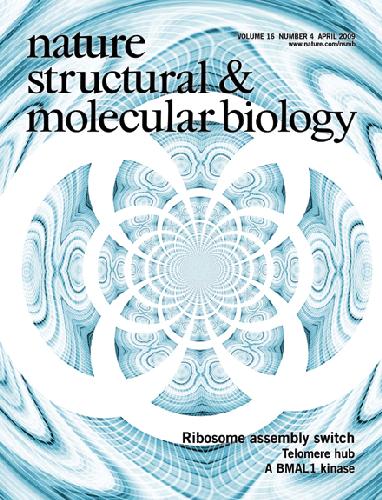Table of contents :
largecover……Page 1
masthead……Page 2
toc……Page 3
nsmb0409-345……Page 5
nsmb0409-346……Page 6
nsmb0409-348……Page 8
nsmb0409-350……Page 10
nsmb0409-352……Page 12
RESULTS……Page 13
Figure 2 Decoding efficiency of the GCC codon by tRNAAlaGGC with the conserved or nonconserved 32-38 pair…….Page 14
Figure 3 Influence of the sequence variation of the 32-38 pair in tRNAAlaGGC on misreading of GUC codon…….Page 15
Figure 4 Overexpression of the conserved or nonconserved tRNAAlaGGC in E…….Page 16
References……Page 17
Mutating A32-U38 has little effect on cognate decoding……Page 19
Figure 1 Secondary structure of E…….Page 20
Figure 2 Comparison of tRNAAlaGGC (wt) to tRNAAlaGGC (UA) on the GCC cognate and GCA near-cognate codons…….Page 21
Figure 3 Time course of peptide bond formation for tRNAAlaGGC (wt) and tRNAAlaGGC (UA) on the cognate GCC codon (taken from Fig.™2d) and the mismatched ACC and GUC codons…….Page 22
Kinetics experiments……Page 23
References……Page 24
A feedback regulatory loop involving microRNA-9 and nuclear receptor TLX in neural stem cell fate determination……Page 25
Figure 1 miR-9-directed repression of TLX expression…….Page 26
Figure 3 TLXDelta3prime UTR rescues miR-9-induced neural stem cell proliferation deficiency…….Page 27
Figure 5 In utero electroporation of miR-9 in embryonic neural stem cells…….Page 28
Figure 6 Regulation of miR-9 pri-miRNA expression by TLX…….Page 29
References……Page 30
Determining the binding specificity of TRF2TRFH……Page 32
Figure 1 The TRFH domain of TRF2 recognizes short peptide sequences…….Page 33
Figure 2 The TRF2-[YF]XL interaction is important for telomere maintenance…….Page 34
Figure 3 TRF2 specifically interacts with YXL-containing proteins PNUTS and MCPH1…….Page 35
Figure 5 MCPH1 and PNUTS regulate DNA-damage response and telomere length, respectively, at the telomeres…….Page 36
Peptide synthesis, fluorescence polarization and affinity measurements……Page 37
References……Page 38
Polyglutamine disruption of the huntingtin exon 1 N terminus triggers a complex aggregation mechanism……Page 40
Table 1 Amino acid sequences of exon 1-related peptides……Page 41
Figure 1 Aggregation kinetics of huntingtin exon 1 mimic peptides exploring various polyQ repeat lengths…….Page 42
Figure 3 State of expansion of the HTTNT peptide in solution…….Page 43
Figure 5 Proton NMR analysis of HTTNT…….Page 44
Figure 7 Time course of aggregation of HTTNTQ30P6 (F17W) by multiple analyses…….Page 45
Figure 9 Mechanism of HTTNT-mediated exon 1 aggregation…….Page 46
Proton nuclear magnetic resonance……Page 47
References……Page 48
RESULTS……Page 50
Figure 1 Fe-S cluster reconstitution on IscU followed by absorbance and CD measurements…….Page 51
Figure 3 Interaction of CyaY with IscS…….Page 52
Figure 5 Gel-filtration profiles to test the state of aggregation of CyaY under the conditions used for cluster reconstitution…….Page 53
DISCUSSION……Page 54
Figure 6 Schematic model of the molecular mechanism of frataxin in the cell…….Page 55
References……Page 56
The pathway of hepatitis C virus mRNA recruitment to the human ribosome……Page 57
Figure 1 Directed hydroxyl radical probing of 18S rRNA from BABE-Fe-eIF3j-40S-HCV IRES complexes…….Page 58
Figure 2 Toeprinting analysis of the 40S-HCV-eIF3j complexes…….Page 59
Figure 3 Effects of eIF3 and eIF2-Met-tRNAi on directed hydroxyl radical probing of 18S rRNA with BABE-Fe-eIF3j…….Page 60
Figure 4 Effects of eIF1, eIF1A, HCV and eIF3 on directed hydroxyl radical probing of 18S rRNA from BABE-Fe-eIF3j…….Page 61
Figure 6 A model for HCV IRES association with the mRNA binding channel of the 40S subunit…….Page 62
References……Page 63
Subdomain folding……Page 65
Figure 2 Cross-linking and accessibility assays for beta- and alpha-hairpins…….Page 66
Figure 3 Accessibility-dependent probability of cross-linking…….Page 67
Figure 4 T1 domain mutants…….Page 68
Dynamics of the nascent peptide-tunnel complex……Page 69
AUTHOR CONTRIBUTIONS……Page 70
References……Page 71
Acetylation by GCN5 regulates CDC6 phosphorylation in the S phase of the cell cycle……Page 72
Figure 1 CDC6 is acetylated by GCN5 on lysines 92, 105 and 109 both in vitro and in vivo…….Page 73
Figure 2 Specific CDC6 phosphorylation on Ser106 depends on GCN5-mediated CDC6 acetylation…….Page 74
Figure 3 CDC6 acetylation is cell cycle dependent…….Page 75
Figure 4 GCN5-dependent CDC6 acetylation regulates its subcellular localization…….Page 76
Figure 5 Characterization of the CDC6 K3R and S106A mutants…….Page 77
Figure 6 Model showing the regulation of CDC6 by sequential modification by acetylation and phosphorylation in early S phase…….Page 78
Statistical analysis……Page 79
References……Page 80
RESULTS……Page 81
Table 1 Steady-state kinetic parameters of the wild-type, D656A and C176A NAD+ synthetaseTB-catalyzed reactionsa……Page 82
Figure 2 Oligomeric assembly of NAD+ synthetaseGln from M…….Page 83
Figure 4 The homooctameric structure of NAD+ synthetaseGln with all eight intersubunit tunnels…….Page 84
Figure 5 The ammonia tunnel and the synthetase active site…….Page 85
Figure 6 Connecting elements between glutaminase and synthetase active sites…….Page 86
Table 3 Data collection and refinement statistics for NAD+ synthetaseTB……Page 87
References……Page 88
Precursor-product discrimination by La protein during tRNA metabolism……Page 90
Figure 1 La can bind non-UUU-3primeOH-containing RNA via contacts that are not mediated by the previously characterized RNA 3primeOH binding site in the La motif…….Page 91
Table 1 Binding properties of mutated La proteins……Page 92
Figure 4 La RRM1 loop-3 mediates UUU-3primeOH-independent tRNA binding…….Page 93
Figure 5 The La loop mutant is defective in tRNA maturation in vivo…….Page 94
Figure 6 Model of involvement of La protein in a tRNA maturation pathway…….Page 95
References……Page 96
RESULTS……Page 98
Figure 2 Hydroxyl radical footprinting of the 5prime domain in the presence and absence of proteins…….Page 99
Figure 4 Primary assembly proteins pre-organize the S16 binding site…….Page 100
Figure 5 S16 discriminates against non-native assembly intermediates…….Page 101
Figure 6 RNA conformational changes during assembly…….Page 102
Figure 7 Model for assembly of the 30S 5prime domain…….Page 103
Data analysis……Page 104
References……Page 105
Figure 1 CK2alpha phosphorylates BMAL1 in vitro…….Page 106
Figure 2 CK2alpha and BMAL1-Ser90 regulate nuclear accumulation and clock function…….Page 107
Figure 3 Circadian phosphorylation of BMAL1-Ser90 by CK2alpha in vivo…….Page 108
Figure 1 H3R2me1 does not block activity of the Set1 complex toward H3K4…….Page 109
Figure 3 H3R2 is necessary for sporulation…….Page 110
References……Page 111
Nature Structural Molecular Biology April
Free Download
Be the first to review “Nature Structural Molecular Biology April” Cancel reply
You must be logged in to post a review.

Reviews
There are no reviews yet.